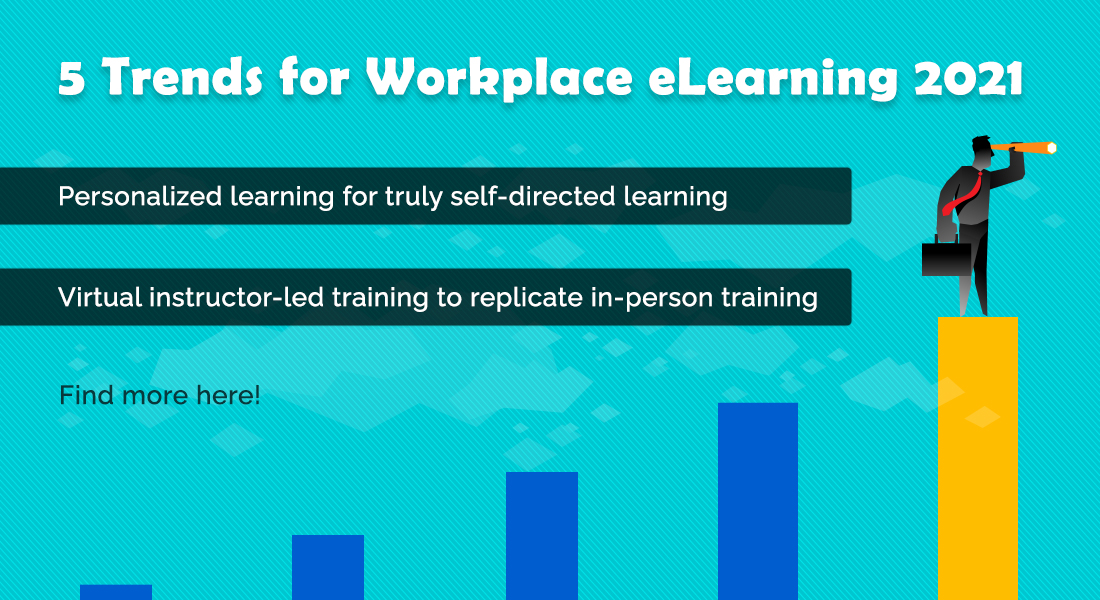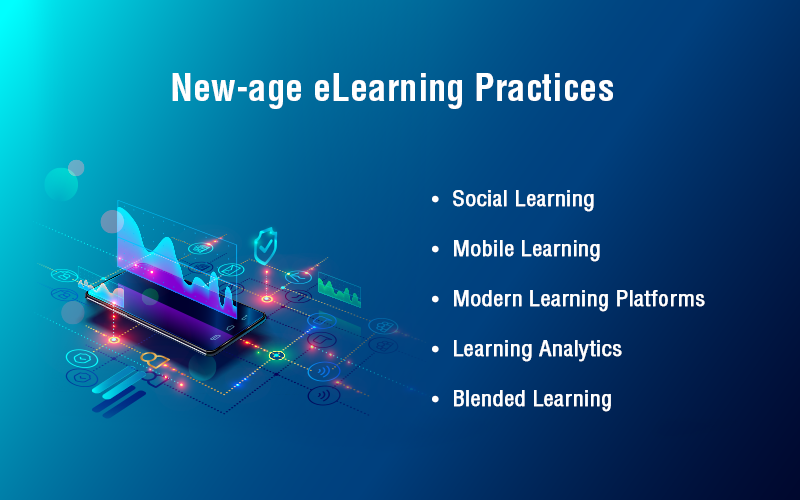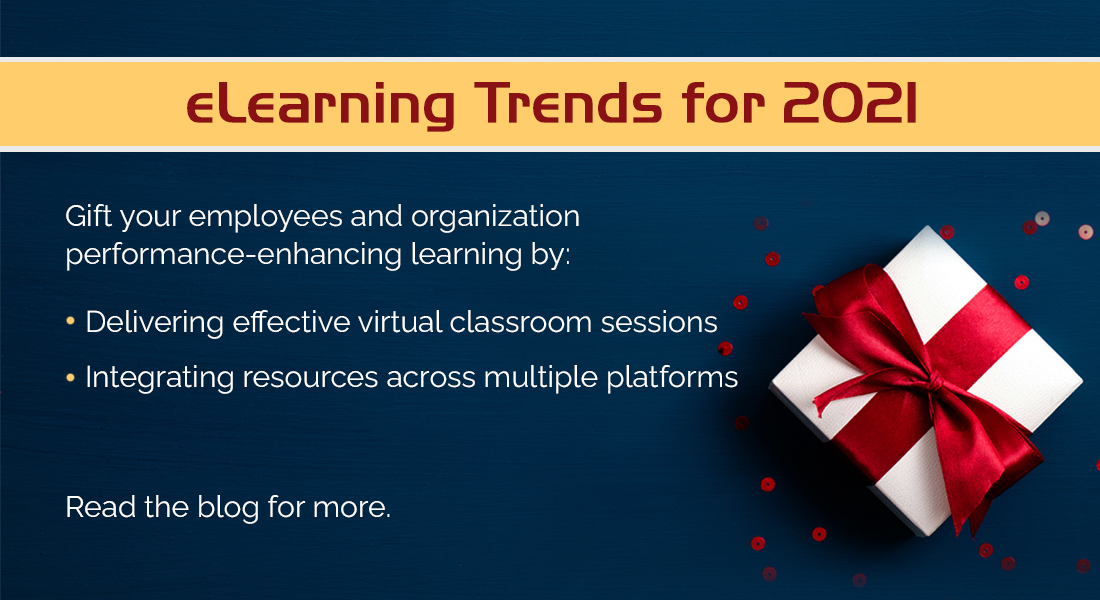5 Trends that will Shape the Future of Workplace Learning

Irrespective of what the eLearning gurus and experts had predicted, what do you think was the biggest trend in workplace learning in 2020? Augmented Reality? Virtual Reality? Gamification?
ELearning Trends for 2021 and Beyond
- Personalized learning for truly self-directed learning
- Virtual instructor-led training to replicate in-person training
- Social learning for better results in minimum support
- 4 ‘R’s for rapid eLearning conversions
- Mobile learning for greater accessibility
While all of these eLearning trends did make it into most of the lists, nobody predicted the exponential growth of online training – either synchronous (Virtual ILT or VILT) or asynchronous (eLearning, microlearning). Organizations that were using eLearning for only a part of training moved for complete digitization while others opted for a hybrid blended approach (VILT + eLearning).
All in all, classroom to online training conversion was undoubtedly the biggest trend of 2020! And if reports are to be believed, eLearning will continue to grow in the years to come. In fact, the eLearning market size is expected to become $375 billion by 2026! (GMI)
In this context, what do you think will be the future of eLearning at the workplace? What trends will shape its growth? Let’s find out!
→ Join us for an exclusive webinar on eLearning trends 2021 – register now!
ELearning 2.0 and Workplace Training – Trends
1. Personalized Learning for Truly Self-directed Learning
If you were the learner, which would you prefer? Being in control of your own training? Or be under your trainer’s or supervisor’s direction? That’s a no brainer, I’m sure! Personalized learning offers unmatched control, allowing learners to take charge of their own learning journey. Having the flexibility to learn at your own pace, and choose your learning resources and delivery formats is certainly more effective than the conventional one-size-fits-all training approach.
Personalization is a buzzword not just in eLearning but also in entertainment, digital marketing, retail, and anything else you can think of. Since everyone has their own strengths and weaknesses, personalized learning helps learners find relevant learning resources for mastering topics with different approaches.
So, it’s not surprising that more than 58% employees prefer to learn at their own pace. It’s actually more impactful and productive since learners can skip topics they’re familiar with or go over other challenging ones as many times as needed.
Most of the new age Learning Management Systems (LMSs) offer support for personalized learning (powered by Artificial Intelligence) where learners can learn in their own unique way.
2. Virtual Instructor-led Training to Replicate In-person Training
Before the pandemic, most of us thought that virtual classrooms are synonymous with webinars (which is definitely not the case) and did not realize its potential for workplace learning. However, VILT has definitely stolen the limelight this year as one of the rising L&D trends at workplace.
This online training method takes the fundamentals of in-person classroom training and replicates its experience through a virtual platform, such as Microsoft Teams, Skype, Zoom, and Adobe Connect, to name a few.
Virtual classrooms are being hailed as the future of classroom training with training being highly interactive and engaging. Learners are given multiple opportunities to participate in discussions, share experiences, practice, and seek answers. VILT sessions are much shorter than classroom sessions (40-60 minutes each) and can be combined with other methods of training such as webinars or eLearning, to create a blended learning program.
This fail-safe L&D trend takes workplace learning forward by offering greater accessibility, especially with remote working as the new normal. It allows your learners to resume their day-to-day routine with minimal disruptions. In addition, VILT is also cost-effective when compared to in person ILT – no travel, accommodation, or venue costs!
Make note of this trend since you’ll be seeing a lot of more of it in the coming years.
3. Social Learning for Better Results with Minimum Support
The next important trend that’ll shape the future of eLearning is social learning. In fact, it is being increasingly incorporated by organizations in their corporate training strategy to promote a continuous learning culture.
Social learning is nothing but learning from others and with others. This can either happen by observing others’ behavior or by learning from the consequences of others’ behavior.
Social learning can bring many benefits, including:
- Reduced time to learn a topic
- Enhanced knowledge retention
- Excellent team building
If you’re thinking it’s too early to jump onto this eLearning trend, then here’s a fact – more than 75% of L&D professionals have incorporated social learning in their training strategy because of its effectiveness.
All you need to get started with social learning is a new-age LMS that supports social learning initiatives, such as:
- Video conferencing – integration with tools such as Zoom, Skype
- Social networking sites
- Collaboration tools – discussion boards
- Instant messaging feature – chat with an SME
If your organization has a dispersed or remote workforce, social learning is definitely a trend you should leverage to encourage knowledge sharing with a minimum of formal intervention.
4. ‘R’s for Rapid eLearning Conversions
What are the two constant challenges of every L&D leader at any given point of time? Budget and timeline! So, whether you’re looking for urgent eLearning development or effective conversion of legacy resources (courses developed in older authoring tools, PDFs, PPTs) into online learning assets, the need for quick n dirty conversion cannot be stressed enough.
Enter the 4 ‘R’ strategies of rapid eLearning!
- Record to save SME time: Maximize the limited time of your SME by reducing their touchpoints during the design and development process with Record strategy.
- Republish for mobile compatibility: Convert your non-responsive legacy courses (developed using older versions of tools) by using a newer version of a rapid authoring tool with Republish strategy. You can also revamp the look-and-feel of the courses, make them mobile-compatible, and more!
- Rebuild for Microlearning: Offer the flexibility of anytime anywhere learning by opting for microlearning. Trim down your lengthy conventional training programs to microlearning nuggets for better knowledge absorption and retention with Rebuild strategy.
- Redesign for blended learning: Get over the challenges of in-person classroom training by opting for Redesign strategy. You can migrate your classroom training to eLearning, VILT, and digital performance support assets as well as blended learning (for the best of classroom and online).
If your organization wants to grow at the speed of business while combating dynamic external factors, internal processes, and unforeseen challenges, the 4 ‘R’s eLearning trend is the way to go!
5. Mobile Learning for Greater Accessibility
Mobility has become the most crucial part of our daily lives. To illustrate – there were over 6.8 billion mobile users in 2019 when the world population was 7.7 billion. This means that nearly 89% used a mobile device. And the number of mobile users is set to reach 7 billion by 2021.
As the number of mobile users grows, so do the number of people preferring mobile learning. 64% of mobile learners claim that accessing training content on mobile devices is essential. 71% of millennials say they connect more with mobile learning than L&D activities delivered via desktops or other formal methods (Docebo). As it happens, enterprises are making mobile learning a part of their learning and development strategy.
Mobile learning has multiple benefits, for instance, it:
- Enables learners to access learning resources anytime, anywhere
- Helps trainers and instructors to monitor learners’ performance closely with online reporting
In a nutshell, mobile learning’s inherent benefits – accessibility and flexibility – will keep it trending in 2021 as well.
Wrapping It Up!
So, these were 5 of the many eLearning trends that we think will shape the future of eLearning. While trends might come and go, online training is going to be there always. If you’re an eLearning geek as well, do you think you can add to this list of eLearning trends?
We would love to hear what you have to say!





